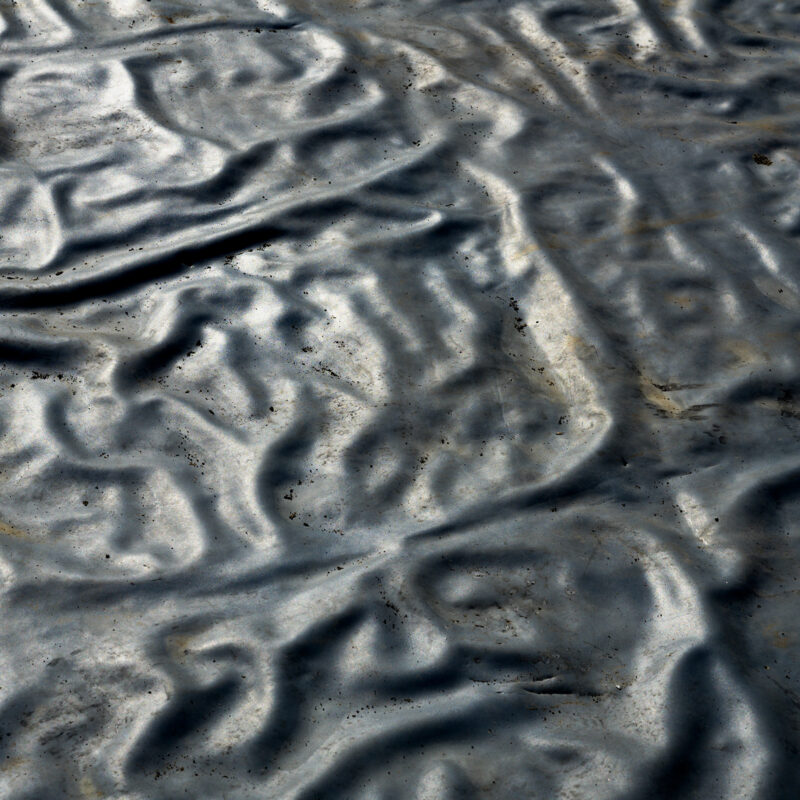Ciao Claudia, parlaci un po’ di te e di come ti sei avvicinata alla fotografia.
Ciao! Dunque onestamente non me lo ricordo, nel senso che per me è sempre stato molto naturale fotografare. Ho sempre viaggiato molto e se all’inizio la fotografia era un mezzo con cui riportare a casa dei ricordi, piano piano è diventata il mio modo per interrogare quello che vedevo, le esperienze che vivevo e le persone che incontravo. E comunicarlo agli altri, che è la parte fondamentale, quello che mi interessa di più.
Come è nato il progetto “Of the Land and us: cartography of oblivion”?
È nato dopo aver visto una mostra, dove erano rappresentati una serie di luoghi contaminati o devastati dall’azione umana. Erano tutte immagini molto forti ma distanti, ricordo di aver pensato: questo messaggio arriva qui, di fronte alle foto, ma una volta a casa si ritorna alla propria routine. È nata cosi l’idea di mettere in relazione diretta delle abitudini comuni del “first world”, del nostro lifestyle, alle conseguenze che hanno sul territorio, con un linguaggio però estremamente estetico, che vuole premere sul clash che si crea tra leggerezza dell’immagine e urgenza del messaggio. L’intenzione non è mostrare gli effetti del cambiamento climatico con foto di paesaggio, ma sottolineare l’azione umana e tutti i segni tangibili che lasciamo sul territorio, ma che in qualche modo “dimentichiamo” perchè lontani dalla nostra esperienza quotidiana.
Da chi prendi ispirazione per i tuoi lavori?
Sono molto onnivora ed eclettica in termini di ispirazione, leggo, ricerco, mi documento e parlo molto con la gente. Fotograficamente parlando, guardo i grandi maestri, talenti emergenti così come instagram! Per questo lavoro in particolare ho letto molte interviste di Burtinsky e rivisto più volte Il sale della Terra di Salgado. Piuttosto che lo stile fotografico mi interessa la poetica e la spinta umana dietro il loro lavoro. Garth Lenz è stato un altro riferimento per questo progetto. In generale adoro Luigi Ghirri, Alex Webb, Alec Soth, Maria Lax, Noemie Goudal, Diana Markosian.
Come trovi le tue storie?
Ho imparato che è fondamentale parlare di cose vicine a noi, non necessariamente fisicamente. Le mie storie nascono tutte da esperienze personali o cose che mi fanno interrogare.
Qual è la prima cosa che fai quando decidi di sviluppare un progetto?
Dipende dal progetto, ma in generale scrivo. Pensieri sconnessi, citazioni, idee, quello che voglio raccontare etc. In questo progetto e in generale in tutti i progetti documentaristici, c’è una componente importante di ricerca. Le foto sono solo una parte del progetto, che in realtà è fatto anche da una serie di mappe, dati e testi che hanno inizialmente informato la scelta di che cosa fotografare, e costituiscono poi una base solida di informazioni necessarie all’approfondimento del messaggio.
Hi Claudia, tell us something about you and how you approached photography for the first time.
Well, maybe because taking photographs has always come naturally to me. I always travelled a lot and, if in the beginning I saw photography as tool to store memories, then it evolved into a way to question the deeper meaning of what I saw, the experiences I lived, the people I met. Sharing it with others, then, became a fundamental part of my job. This is what I find more interesting, I suppose.
What about the project “Of The Land And Us: Cartography Of Oblivion”?
It was born after attending an exhibition featuring portraits of contaminated places, destroyed by the human hand. The photos were really strong, though far from my personal sensibility. I remember thinking that the message behind them could be received as long as one stood in front of the pictures. But once back home, in one’s everyday life, the main tendency would be to let those emotions slip away. So I came up with an idea: to create a relationship between the common behaviours typical of the “first world” and the consequences those have onto our land, using a markedly aesthetic language to insist on the contrast between the ‘softness’ of the image and the urgency of the message. The) intention was to show the human impact on land – something we tend to forget – because distant from our daily experience.
Who’s the main inspiration for your works?
I define myself “omnivorous” and eclectic when it comes to finding my inspiration; I read, search and gather information, while also confronting myself with people. I draw inspiration from either famous photographers and emerging talents, even from Instagram. For this project, in particular, I read several Bartinsky interviews and I rewatched “The Salt Of The Earth” by Salgado. I wouldn’t say my key interest is photographic style stricto sensu, rather the intense human poetry behind their works. Garth Lenz has been another source of inspiration for this project. Generally speaking I look up to artists like Luigi Ghirri, Alex Webb, Alec Soth, Maria Lax, Noemie Goudal, Diana Markosian.
How do you find your subjects?
I’ve come to appreciate the importance of dealing with what is close to our own life, and not just physically. All of my subjects arise out of my personal experience or things that make me question myself.
What’s the first thing you do when you decide to develop a project?
Well, It depends on the project, though I usually write things down. Random thoughts, quotes, ideas, what I want to tell. In this project, but usually in all documentary-styled projects, there’s an important research component. Photos are only a part of the work, that is thereby composed by maps, data and texts, which influence my choice of what to photograph in the first place, but then become information sources instrumental to deep-dive in the project itself.
More on:
Website: Claudia Orsetti
Instagram: Claudia_Orsetti_photography

























